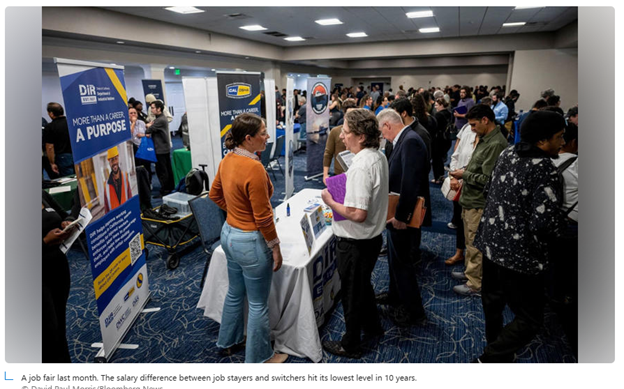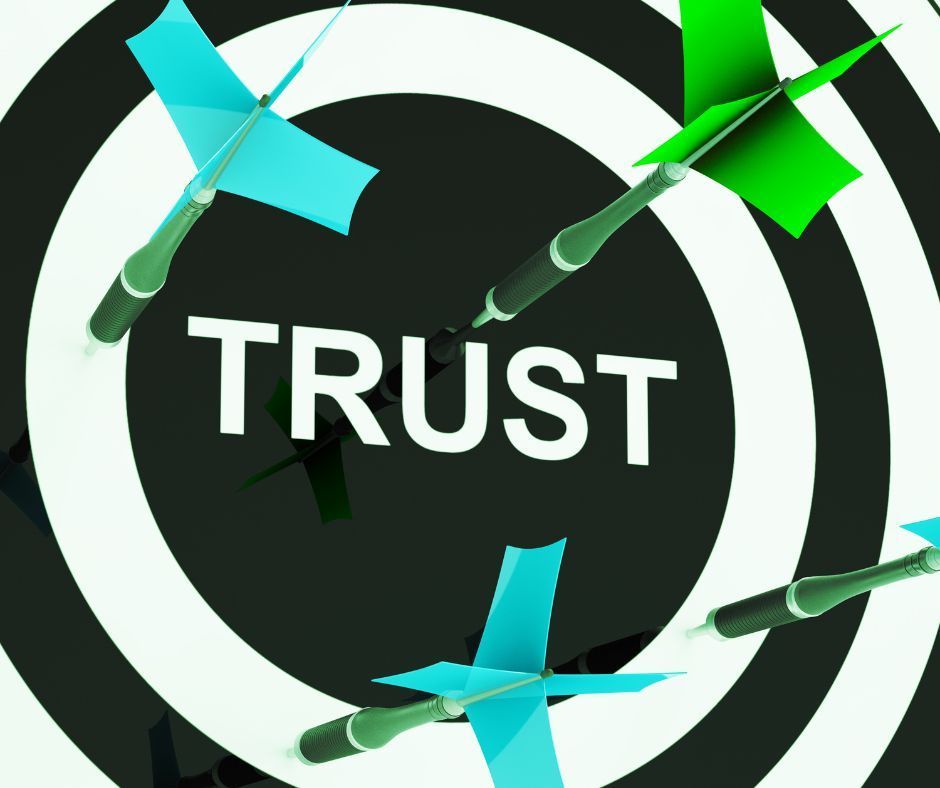Blog

Hiring managers are getting fed up with the in-person interview antics of Gen Z applicants, pointing to behaviors that are creating a bad impression of this younger but increasingly important segment of the nation's workforce. The latest survey of hiring managers by Resume.org found that 56% of respondents said they have had Gen Z applicants in the last year who were unprepared for their job interview. Some of the biggest complaints were poor communication skills, unprofessional attire and a sense of entitlement. Among the anecdotes shared, 16% said they witnessed a Gen Z applicant use their phone during a job interview, while 11% brought a parent, partner or friend to the interview. Twenty-three percent of hiring managers also said they found Gen Z candidates inflating their qualifications or misusing artificial intelligence in their applications. “Many Gen Zers are very comfortable with online communication. However, in face-to-face interviews, non-verbal cues, such as eye contact, body language and tone are very important and often less polished,” said Resume.org career coach Irina Pichura in a report with the survey results. “Growing up in an era of texting and social media, some come off as too casual, and a more-professional demeanor is expected.” The survey comes amid a softening job market in which many applicants are unable to get in-person interviews , or have to navigate “ghost” job postings from companies never intending to fill the roles advertised . The rise of AI also has created a flood of candidates whose applications are then sorted by AI programs on the hiring side, creating a kind of job-market black hole . Even before the job interview, about 40% of hiring managers say Gen Z resumes rank as “low quality,” with issues such as frequent spelling and grammar mistakes and missing information — with 16% finding lies as well. Pichura said Gen Z applicants should focus less on listing responsibilities they had on their resume and more on measurable accomplishments, such as the number of clients or customers they assisted or the impact of their work. While education is important, employers prioritize real-world experience rather than just coursework. “A resume is your first impression with an employer and determines whether you get an interview, making it essential to craft it well,” Pichura said. “Younger applicants often struggle with resume writing and should focus on showcasing how their education and past experiences translate into job-relevant skills.” That doesn’t set up Gen Z to make a good impression at the workplace either, with 18% of hiring managers describing Gen Z workers as “poor” or “terrible.” Younger workers create challenges for hiring managers The Resume.org survey is not the only one recently to showcase hiring managers' distaste for younger workers. When given a choice, 37% of hiring managers surveyed by Workplace Intelligence on behalf of Hult International Business School said they would rather have a robot or AI do the job than hire a new grad . Forty-four percent said they would rather give the job to an existing freelancer instead of a new grad, and 45% would rather recruit and rehire a worker who has retired than bring on a graduate. Thirty percent even said they would rather leave the position unfilled if the only other choice was filling it with a new grad. According to the research, 52% agree or strongly agree new college graduates don’t have the right skill sets. Additionally, 55% agree or strongly agree with the idea that new grads don’t know how to work well on a team, and 49% agree or strongly agree they have poor business etiquette. Sixty percent agree or strongly agree they avoid hiring new grads because those new employees don’t have enough real-world experience, and 54% say it costs too much to train them. The focus on Gen Z hiring is part of a wider shift in how younger workers approach the job market. A survey by career service Zety found 46% of Gen Zers secured a job or internship using TikTok . Additionally, 92% said they trust TikTok for job and career advice, despite 55% saying they've followed misleading advice on the platform. Members of Gen Z also are far more likely to use Instagram and TikTok than LinkedIn for their job search, according to the survey, in addition to using Instagram to connect with peers, mentors and industry professionals. Of course, demographics are on the side of new graduates and other members of Gen Z, as that generation — which has a significantly smaller number of individuals than the millennial generation before it — enters the workforce. That sets up a big, long-term problem for companies looking to keep up with recruitment. Gen Z members, however, are also likely to be the least happy with the jobs they have , creating a generational divide in job satisfaction. According to a survey of roughly 3,000 workers conducted by background and employment-check company Checkr, 44% of respondents said they were happy at work. That number fell to 35% for Gen Z workers compared to 50% for both baby boomers and Gen X workers. Millennials were also less happy than the average, at 42%. Credit: Andy Medici - Senior Reporter, The Playbook, The Business Journals

It used to pay to switch jobs. Now it doesn’t. The salary difference between those who stay in their roles and those who change jobs has collapsed to its lowest level in 10 years, according to the latest federal data. Job stayers increased their wages by about 4.6% in January and February. Meanwhile, those who switched jobs received only slightly more at 4.8% . That gap has narrowed considerably since the start of 2023, when job switchers could fetch an average salary bump of 7.7%, compared with job stayers’ 5.5%. “We’re not in a recession obviously, but things are not as good as before,” says Yongseok Shin, a professor of economics at Washington University in St. Louis. “People are responding by staying put.” Keith Sims runs Indianapolis recruiting firm Integrity Resource Management and places teams of five to 40 people in software implementation with big companies such as Panasonic. Many offers are coming in low these days. “We’re seeing wages be off from expectations most of the time,” he says. Kim Vandrilla, 42, had been working as a creative director for a major consumer brand up until this past fall when she was laid off. She was making more than $200,000. During her job hunt, she is finding the same role listed for $140,000 to $160,000. “And that’s at the high end of the range,” she says. “My first role as a creative director was for $175,000, and that was in 2017.” Even in the tech industry, where not so long ago workers bounced around for big raises with ease, more people are hanging on to the job they have. Workers who negotiated their salaries during the pandemic when the sector drove big pay increases, especially at high-growth tech firms, aren’t likely to find a new job for more money than they are already making. “There’s little incentive for those folks to go out and look for a new job,” says Zuhayeer Musa, co-founder of Levels.fyi, a platform for salary data. In the second half of 2024, median pay decreased between 1% and 2% for several roles, including software engineers, product designers and technical program managers, according to Levels.fyi data. Bumps in pay were reserved for certain high-demand employees such as hardware engineers and data scientists. “There’s two sides to this market depending on whether you’re in AI or not,” Musa says. Senior and midlevel leaders in tech face the most pronounced pay drops of between $10,000 and $40,000 a year, says Michael Butts, chief executive of Burtch Works, a staffing company that tracks compensation for executives and white-collar professionals around the U.S. Even in artificial intelligence, managers overseeing machine-learning teams have seen compensation shrink by $10,000 to $20,000 a year as companies focus on hiring practitioners over leaders. Josh Vogel was working as a director of customer success for a company that makes golf simulators when he was laid off in October. He spent five months job hunting and submitted his résumé to 2,500 positions using AI to populate the application fields. Vogel found during interviews that companies seem to be looking for the so-called perfect candidate—somebody who checks every single box. “During the Covid era, I experienced a lot of career hypergrowth,” he says. “That seems to be getting course corrected.” And wiggle room when it comes to salary negotiations ? Gone. If the role is advertised as $100,000, that’s what it pays. Vogel recently accepted a job as a customer success manager for a benefits technology firm. He is making $120,000 a year, which is $50,000 less than his former role and his overall compensation is even lower once he takes into account the annual bonus he used to get. “No one is paying what they used to,” he says. “If you don’t like it, there’s 50 people behind you they’re going to call right afterward.” ‘Things can change on a dime’ As higher-paying roles become rarer and layoffs continue to ripple through the workforce, fewer people are quitting . The number of American workers who quit their jobs last year hit the lowest level since 2020, federal data show, and some economists expect even fewer people to quit in 2025. “People are still getting laid off, and I’m not sure that firms are putting a whole lot of budget into replacement salaries,” says David Ellis, a senior vice president at Korn Ferry, an organizational consulting firm. Meanwhile many internal job changes amount to a “dry promotion” —one that comes with a bigger title and more responsibility but without the money to match—because companies are dialing down what they earmark for raises. This year’s average projected raise for employees who stay in their jobs is 3.7%, down from 4% last year and 4.4% in 2023, according to Willis Towers Watson, a workplace advisory firm. One bright spot: finance. Over the past six months, most senior-level candidates that executive recruiter Paul Sorbera has worked with have been able to command a bigger salary when changing jobs. “Some of the banks had record earnings. They’re doing pretty well,” says Sorbera, president of executive search firm Alliance Consulting. “When they make money, they go out and spend money.” For finance-job candidates with five or more years of experience, Sorbera has seen some aggressive hiring and found healthy competition among large banks. Still, he cautions, “One thing that happens on Wall Street is these things can change on a dime.” Credit: Katherine Bindley

Have you ever tried to break a bad habit, only to give up in frustration? The problem isn’t that you’re weak or that the bad habit is too ingrained; in all likelihood, you just gave up too soon. Researchers at University College, London, found that it takes 66 days for a new habit to form. Likewise, as long as there is no physical addiction involved, it takes 66 days for you to shake a bad habit. But before you can develop the motivation to stick it out for that long, you need to understand how bad habits form in the first place. Bad habits are formed and reinforced via the habit loop. First, something triggers you to initiate an undesired behavior. Maybe you’re feeling stressed, so you decide to numb out on social media for an hour or eat a whole bag of Flamin’ Hot Cheetos. The trigger event is whatever puts this idea in your head. The second step is the behavior itself. Your brain says, “Sure, you deserve some Flamin’ Hot Cheetos,” so you dig in. The third step—and this part is crucial—is the reward. The behavior has to reward you in some way. That doesn’t mean it’s good for you or that it’s smart, just that it does something that your brain likes. Numbing out on social media might help you forget your problems for a while or to put off something that you don’t want to do, and we all know, all too well, the reward that comes from eating a bag of junk food. For better or worse, these rewards increase the likelihood that you’ll repeat the behavior. Once you repeat a behavior enough times, the habit loop becomes so automated that you don’t even think about it anymore. Instead of making a conscious decision to procrastinate, you just automatically pull up Instagram as soon as you sit down at your desk or you’re digging into the Cheetos before you even realize that you’re feeling stressed. Once a habit becomes automatic, it’s a lot harder to break—and that’s why you’re probably failing if you’re not giving yourself 66 days to wean yourself off it. Sixty-six days might seem like a long time, but there are specific stages you have to go through that will make the process feel much shorter. Let’s take a look at these. Days 1–10: Look Inward It’s usually pretty obvious which bad habits are causing the most problems in your life—the ones that keep coming up in performance appraisals or sparking arguments with your spouse. Once you’ve identified a habit to change, the real challenge lies in understanding your triggers, and that can be harder than it sounds, especially if the habit has become so ingrained that you do it subconsciously. If you give it enough thought, you’ll get to the bottom of it. Maybe you keep getting tickets for speeding, and you realize that you drive too fast when you leave work in a bad mood, or maybe you snack when you’re stressed. Looking inward to explore the source of the habit you’re trying to break makes breaking that habit possible. The first 10 days of trying to break the habit will provide substantial insight into the source of the habit, should you choose to look. Days 11–40: Spread the Word Accountability is crucial in breaking bad habits. In this stage, you create a very vocal accountability network by telling everybody you can about the habit you’re trying to break, and the more vocal you are about it, the more likely people are to call you out when you slip up. Let them know that you really want them to say something. Just remember that you might have to keep reminding them—it’s just as easy for them to forget and backslide as it is for you to do so. Days 41–66: Mind Your Relapse Triggers As you head for the home stretch, be ready to make some mistakes—it happens to everybody. Just be on the lookout for common threads running through those mistakes. If you tend to relapse in a certain situation, you’d be smart to avoid that trigger completely until you feel that your bad habit is really extinguished. Keeping your triggers from surprising you when it feels like you’ve kicked the habit is typically the difference between success and failure this late in the process. Day 67: Reward Yourself Sure, you could say that breaking the habit is its own reward, but why pass up an opportunity to celebrate? Just don’t celebrate by indulging in the habit you worked so hard to break! You should also use this opportunity to reflect and select the next habit you’re going to break. Moving Forward You’re not weak, stupid, or lazy if you have a hard time breaking bad habits. There are psychological factors that make this process challenging for everyone, but the very science behind what makes habits hard to break also provides a research-supported method for doing it. Focus on one habit at a time and follow these steps and the timetable that goes with them, and your chances of success will go through the roof. Credit: Travis Bradberry, The New Emotional Intelligence

Amid growing support for skills-first hiring practices, employers are becoming less likely to require formal education credentials for jobs. Key points : A majority (52%) of US job postings on Indeed did not mention any formal education requirement as of January 2024, up from 48% at the same time in 2019. The share of US job postings requiring at least a college degree fell from 20.4% to 17.8% in the last five years, opening doors for the 64% of US adults without a bachelor’s degree. Formal educational requirements are declining in nearly every sector, and mentions of college degrees have fallen since 2019 in 87% of occupational groups analyzed by Indeed. Employers are loosening their formal education requirements as the labor market remains tight and attitudes towards skills-first hiring practices change. Those same employers seem more willing to consider candidates who can demonstrate the required skills without necessarily having a degree. Fewer than 1-in-5 (17.8%) US job postings on Indeed required a four-year degree or more in January 2024, and a majority (52%) did not include any educational requirements at all, up from 48% in 2019. Educational requirements have loosened over the past half-decade in 41 of the 47 (87%) occupational sectors analyzed by Indeed, and the pullback is larger in some sectors — including tech-adjacent information design & documentation and software development — than in others. Formal educational requirements are unlikely to disappear entirely from job postings, especially in areas like healthcare and engineering that require a good deal of post-secondary knowledge and skills. However, a shrinking pool of job postings requiring applicants to first hold a formal degree as an employment condition represents a major opportunity for the roughly two-thirds of Americans without a four-year degree. Workers willing to prioritize skill development and embrace emerging technologies like generative artificial intelligence (GenAI) will likely benefit as employers adopt skills-first hiring approaches to attract the best candidates. And employers can reap the benefits of an expanded candidate pool, which may prove vital in coming years as demographics and an aging population weigh on worker supply .

Entering a new year is an opportunity to reflect, plan, and set the tone for your professional journey. As a senior professional, taking a strategic approach to your career in 2025 will help you navigate the evolving job market and position yourself for long-term success. Here are five essential tips to ensure you hit the ground running. Embrace adaptability The pace of change in the workplace continues to accelerate, driven by advancements in technology, shifting economic conditions, and the global push towards sustainability. As a senior professional, demonstrating adaptability is vital to staying ahead. This means being open to new ways of working, technologies, and methodologies. Upskilling in areas like artificial intelligence, digital transformation, or data analytics can enhance your relevance and expand your leadership potential. Adaptability isn’t solely about technical skills—it’s also about emotional intelligence and the ability to lead through change. Understanding how to manage transitions within your organisation while keeping your team motivated is a highly valued trait. Communicating transparently and fostering a culture of collaboration are essential to adapting successfully. By cultivating a flexible mindset, you’ll be better equipped to tackle challenges, embrace innovation, and seize new opportunities in an ever-evolving professional landscape. Update your CV A well-written CV is the cornerstone of your career strategy for 2025. With recruitment processes becoming more competitive and technology-driven, having an impactful CV tailored to your career goals is essential. As a senior professional, your CV should focus on quantifiable achievements, leadership experience, and the unique value you bring to organisations. Start by crafting a compelling personal profile that highlights your expertise, career aspirations, and recent accomplishments. Structure your CV clearly, using clean formatting and standard headings like “Career Summary” and “Core Skills” to ensure it is both ATS-friendly and engaging for recruiters. Tailor your content to match the roles you are pursuing, focusing on skills and achievements that align with the job description. By investing time into creating a strong, focused CV, you increase your chances of standing out in a competitive market. Build meaningful connections through networking Networking remains one of the most powerful tools for advancing your career. As a senior professional, leveraging your existing network while actively cultivating new connections can open doors to unadvertised roles and strategic partnerships. Attend industry events, join professional associations, and engage on platforms like LinkedIn to remain visible and connected. Focus on quality over quantity—meaningful connections are far more valuable than an extensive but superficial network. Building authentic relationships requires effort and intention. Engage with your contacts by sharing insights, offering mentorship, and collaborating on projects. Position yourself as a resourceful and trustworthy leader. Networking isn’t just about seeking opportunities; it’s about creating them by fostering mutually beneficial relationships. For senior roles, a strategic approach is key. Take time to identify influential contacts within your industry and connect with decision-makers. Demonstrating your expertise, whether through industry discussions or thought leadership, makes you a standout professional worth knowing. The stronger your network, the more opportunities you’ll create for the year ahead. Prioritise Continuous Learning In today’s dynamic job market, continuous learning is no longer optional; it is essential. A commitment to professional growth not only enhances your skill set but also signals to employers that you are forward-thinking and invested in staying competitive. For senior professionals, this often involves targeted upskilling in leadership development, emerging technologies, or areas like sustainability and digital transformation. Explore formal learning options, such as executive courses or certifications, to strengthen your credentials. Additionally, informal methods like reading industry publications, following thought leaders, or participating in webinars are excellent ways to stay informed about trends and challenges. Seek learning opportunities that align with your long-term career goals. Adopting a growth mindset demonstrates your ability to adapt and excel in changing environments. It also ensures that you remain confident when navigating the demands of your role. By staying curious and proactive, you position yourself as a valuable leader capable of driving innovation and progress within your organisation. Cultivate work-life balance Senior professionals often face the challenge of managing demanding roles alongside personal commitments. Striking a healthy work-life balance is essential for sustained success. Overworking can lead to burnout, which compromises productivity, decision-making, and overall wellbeing. To thrive in 2025, prioritise balance as a core element of your professional strategy. Set clear boundaries to protect your personal time and recharge effectively. Communicate with your team about expectations, ensuring that everyone respects your downtime. Incorporate habits that promote physical and mental health, such as regular exercise, mindfulness practices, or time spent with family and friends. Remember, work-life balance is not just beneficial to you—it positively impacts your effectiveness as a leader. A rested, focused professional inspires confidence and fosters productivity in others. By modelling healthy habits, you also contribute to creating a more supportive and sustainable workplace culture. Starting 2025 with a proactive, thoughtful approach will help you make it a year of growth and opportunity. By focusing on adaptability, writing an outstanding CV, networking, continuous learning, and work-life balance, you’ll be well-positioned to navigate challenges, embrace innovation, and thrive in your professional journey. Credit: Andrew Fennell

As we enter 2025, the United States job market finds itself at a crossroads. Despite low unemployment and declining quit rates in 2024, employees are experiencing unprecedented levels of dissatisfaction and disengagement. The psychological state of workers has reached a critical point, with employee well-being hitting new lows. According to Gallup's latest workplace well-being indicator , only 50% of U.S. employees report thriving in their overall lives, marking a record low since measurements began in 2009. The downturn in employee well-being has continued unabated post-Covid. The new year presents a significant challenge for leadership: motivating and guiding teams through periods of substantial change and uncertainty. Employers aiming to introduce organizational changes and adopt new workplace trends will struggle to achieve their goals if their employees feel disengaged. Labor Market Trends For 2025 As the employment landscape continues to evolve rapidly in 2025, adaptability and resilience will be critical for workers seeking to thrive in an increasingly uncertain labor market. The ability to pivot quickly, learn new skills and maintain a positive outlook in the face of challenges has become not just desirable, but essential for career success. In this new paradigm, workers who can effectively navigate change and bounce back from setbacks are positioning themselves as valuable assets to their organizations and industries. 1. Increasing Integration Of Artificial Intelligence As businesses seek to enhance productivity, streamline operations and gain competitive advantages, the adoption of artificial intelligence is becoming increasingly crucial for future success. The momentum behind AI and automation adoption is already significant. A survey by ADP reveals that more than half of employers are actively working to close generative AI skills gaps through targeted upskilling programs, as the majority of businesses are already integrating AI into their operations or actively exploring its implementation. This widespread adoption is driven by the potential for substantial economic impact, with AI estimated to contribute $15.7 trillion to the global economy by 2030, according to PwC. 2. Full Return To Office Companies are increasingly pushing for a shift away from remote work models adopted during the pandemic. Eighty-three percent of chief executives globally predict that companies will require a full return to office within the next three years, according to a CEO outlook survey by KPMG. However, the transition is not without controversy, as it represents a significant change in work-life balance for many employees who have grown accustomed to the flexibility of remote work. There is likely to be continued employee resistance against return-to-office mandates, as demonstrated by the recent backlash at Amazon. 3. Adoption Of Skills-Based Hiring Skills-based hiring is set to dominate recruitment practices in 2025, as employers increasingly prioritize candidates' competencies over traditional credentials. This reflects a growing recognition of the limitations of degree-focused hiring methods and the need to address talent shortages. By focusing on tangible skills and hands-on experience, companies can tap into a broader, more diverse talent pool. According to Indeed Hiring Lab, 52% of U.S. job postings on its platform did not mention any formal education requirement as of January 2024, up from 48% in 2019. Moreover, ADP research found that 94% of organizations that have implemented skills-based hiring reported this approach more accurately predicts on-the-job success compared to traditional résumé screening, leading to increased retention. 4. Rise Of Blue And Gray-Collar Jobs There is now a greater demand for skilled trades and hybrid roles that combine manual labor with technical expertise, challenging traditional notions of work and opening up new career opportunities across various industries. More than a third of the fastest-growing jobs in the U.S. are blue-collar roles, with over 1.7 million positions projected by 2032, as reported by the Bureau of Labor Statistics. The growing prestige and financial rewards associated with the skilled trades are positioning these occupations as formidable alternatives to white-collar jobs, challenging long-held assumptions about career paths and success. Additionally, the rise of gray-collar jobs is also evident, as these roles are projected to dominate the list of occupations with the highest employment growth between 2022 and 2032. Gray-collar roles are at the intersection of traditional “blue-collar” and “white-collar” jobs. These hybrid roles combine aspects of both hands-on, physical labor—often involving the operation of tools, machinery or equipment—and technical skills or knowledge. Credit: Jack Kelly

Reading is often regarded as a gateway to knowledge, creativity, and personal growth. For tech moguls Elon Musk, Jeff Bezos, and Bill Gates, this habit has been instrumental in shaping their paths to unparalleled success. Despite their differing industries and business ventures, all three have one shared cornerstone: an enduring love for books. From shaping innovative ideas to inspiring entrepreneurial ventures, reading has profoundly impacted their lives and careers. This article explores how this seemingly simple habit contributed to their meteoric rise and continues to influence their approach to work and life. How reading shaped the success of Elon Musk, Jeff Bezos, and Bill Gates Jeff Bezos: From book lover to building Amazon Jeff Bezos, the founder of Amazon, has always had a profound appreciation for books. His passion for reading influenced the very foundation of his business empire. In 1995, Amazon was launched as an online bookstore, revolutionizing how people shopped for and accessed books globally Personal connection to literature: Bezos' affinity for books extends beyond business. Married to novelist Mackenzie Scott for 25 years, he was deeply immersed in the world of literature, particularly science fiction. He has often credited his love for novels with shaping his creativity and vision. Reading as a business catalyst: Bezos used his love for books to create Amazon’s user-friendly browsing experience, enabling readers worldwide to access a vast library of content. His passion for storytelling and innovation has ensured that Amazon remains a top platform for both readers and authors. Elon Musk: A voracious reader with a vision Elon Musk’s relationship with books began during his childhood in South Africa, where he reportedly read up to 10 hours a day. His fascination with science fiction and encyclopedias set the stage for the innovative mind that would later create Tesla, SpaceX, and Neuralink. Self-education through reading: Musk’s early exposure to books like The Hitchhiker’s Guide to the Galaxy not only fueled his imagination but also provided him with unique problem-solving perspectives. When asked how he learned to build rockets, Musk famously replied, “I read books.” Incorporating reading into AI development : Musk’s love for literature also reflects in his ventures. His artificial intelligence initiative, xAI, and its chatbot GrokAI draw inspiration from the themes of The Hitchhiker’s Guide to the Galaxy, showcasing how literature informs his technological innovations. Bill Gates: A lifelong love for learning Microsoft co-founder Bill Gates has consistently emphasized the importance of reading in his personal and professional life. Gates spends hours each day reading, with a preference for non fiction works that broaden his understanding of the world. Reading for reflection and advice: Gates often shares his reading lists with the public, highlighting books that have shaped his thinking. In a LinkedIn post, he revealed that the advice he would give his younger self is to “read a lot” and discover a skill you enjoy. His focus on learning through books underscores the belief that knowledge is key to making a positive impact. Recommendations for success: Gates' reading habits extend beyond personal development. He often recommends books to his followers, encouraging them to embrace a lifelong commitment to learning Credit: TOI Tech Desk

Ask any sales professional and you’ll understand that sales objections are a normal part of the sales process. Frustrating, of course, but normal. But while not every sales call will end with a sale, many (and perhaps most) sales objections can be overcome if you enter into interactions armed with a strategic understanding of common objections and ways to confidently manage them. What is a Sales Objection? Simply put, a sales objection is any response from a customer or prospective buyer that stalls any aspect of the salesperson’s presentation of their solution’s features, benefits, and cost. A sales objection does not necessarily mean the sale is lost; only that more discussion and “selling” is necessary to overcome the objection(s). Three Essential General Rules for Overcoming Sales Objections Before exploring specific ways to overcome common sales objections, it’s important to understand universal best practices to use in any sales situation: Listen. Don’t interrupt as you allow the buyer to state an objection. Seek to understand. Ask questions to clarify any parts of the objection that might not be clear. Respond respectfully. When responding to objections, state your appreciation of the buyer’s position and then respectfully offer specific insights to counter the objection. Common Sales Objections and How to Overcome Them Perhaps the most common sales objections fall into these categories: price, need, time, competition, and authority. Here’s how to overcome these types of sales objections: Price Objection Stated objection: "Your product/service is too expensive." To overcome the “price” objection: Focus on value and ROI: Demonstrate how your product or service will save the customer money or increase revenue over time. Offer favorable pricing or terms: Get creative with pricing tiers, packages, or payment terms to make the immediate impact of cost less objectionable. Spotlight the cost of inaction: Quantify potential losses or opportunity costs that could arise from not moving forward. Need Objection Stated objection: "We don't really need your product/service." To overcome the “need” objection: Identify “pain points”: Dig deeper to uncover underlying customer challenges and needs. Spotlight solutions: Demonstrate how your solution addresses specific pain points. Create urgency: Explain how their “pain” could get worse unless addressed soon. Offer a free trial or demo: Showcase your product or service's unique features and benefits working in the buyer’s environment. Time Objection Stated objection: "I'm too busy to consider this now." To overcome the “time” objection: Respect their time: Watch for non-verbal cues that they are anxious to move on to other pressing issues; accordingly, be concise and focused as you present your solution. Be flexible: Offer follow-up options, such as email, phone, video chat, or future in-person meetings at a more convenient time; above all, keep the communication channels open. Generate anticipation: To pique interest, briefly mention important or forthcoming features and benefits, as well as limited-time offers. Competition Objection Stated objection: "I like your competitor's product/service better." To overcome the “competition” objection: Ask “Why?”: Without being defensive, dig deeper to determine what features or benefits (or cost) the buyer prefers in the competitor’s solution. Provide direct comparisons: Compare specific features or benefits where your product excels; if cost is an issue, manage that objection as noted above. Authority Objection Stated objection: "I need to consult with someone else about this before we can make a decision. To overcome the “authority” objection: Gather information: Ask for details to better understand the decision-making process and timeline. Offer support: Provide materials or information to share with all decision-makers. Also, make yourself available to everyone who would be involved in the decision. The Bottom Line Successful sales strategies include effective objection-handling techniques. While not all customer “pushback” can be overcome, by listening to objections, understanding objections, and responding respectfully using these situation-specific methods for handling objections, you can potentially build a solid customer relationship. Credit: Sales Xceleration

Beginning your job hunt can be daunting. Follow our job search tips to stand out from the competition and land a position that aligns with your career goals. Whether you’re a recent graduate , a seasoned professional looking for a change, or someone reentering the job market after a break, these job search tips will help you land the job you’re after. 1. Research companies or organizations you’re interested in Be selective in your job search. Instead of applying to as many jobs as possible, take the time to research companies so you can focus on applying to jobs you’re genuinely interested in. Start by browsing some of the best job boards for your industry (there’s more out there than Indeed). Take note of any positions you think would be a good fit, and do some research into each company. Find out more about what it does, its mission, and its company culture. A good place to start is the company’s “About” page (if it has one). You can also find company reviews and salary ranges on Glassdoor. Researching the companies you’re interested in helps you decide which jobs to apply for and gives you a better understanding of what each company is looking for so you can effectively tailor your application to each position. 2. Set up job alerts Timing can be everything when searching for a new job. Setting up job alerts makes it so that you’re among the first to know about new opportunities that match your qualifications. Most major job boards and professional networking sites offer customizable alert features. Take advantage of these by creating specific alerts based on job titles, companies, locations, and keywords relevant to your target position. Don’t limit yourself to just one platform. Set up alerts on multiple job search sites and company career pages. 3. Attend job fairs and industry events Job fairs and industry events, whether virtual or in-person, are essential resources for job seekers. These events offer direct access to multiple employers and provide opportunities to learn about various companies and roles. Virtual job fairs allow you to connect with employers from the comfort of your home, often featuring chat rooms, webinars, and even virtual booths. In-person events, on the other hand, offer the advantage of face-to-face interactions and the ability to make a strong first impression. Whichever format you choose, come prepared with your elevator pitch, questions for employers, and updated resumes. 4. Reach out to recruiters Recruiters often have inside knowledge of job openings, some of which may not be publicly advertised. Start by identifying recruiters who specialize in your industry or field. LinkedIn is an excellent platform for finding and connecting with recruiters. Be clear about your career goals, experience, and the type of positions you’re seeking. Provide a concise and accurate summary of your skills and achievements. Be courteous and responsive to their inquiries. Building a good relationship with recruiters can not only help with your current job search but also benefit your career in the long term. 5. Tailor your resume and cover letter to each job Customizing your resume and cover letter for each application is key in today’s competitive job market. To make this process easier, start by creating a comprehensive master resume that includes all of your experiences, skills, and achievements. Then, when applying for a specific position, use this master resume to quickly pull relevant experiences and tailor them to the job requirements. Focus on highlighting skills and achievements that directly align with the job description. You can use a similar strategy for cover letters. Try writing a general cover letter and filling it in with details that are relevant to each job you’re applying for. This approach allows you to maintain consistency in your career narrative while emphasizing the most relevant skills and achievements for each application. 6. Apply to each job thoughtfully Quality beats quantity when it comes to job applications. Resist the urge to send out as many applications as possible. Not only will this burn you out, but hiring managers can spot a rushed application from a mile away. Instead, apply to just two or three jobs that you’re strongly interested in every day and follow the application instructions carefully. As you apply for each job, go through and ask yourself the following questions to make sure every part of your application looks professional and is free of mistakes: Questions to ask yourself when you apply to jobs: Is your contact information accurate? Does your resume fit on one page (or two pages if you’re highly experienced)? Does your cover letter fit on one page? Does your resume include all the necessary sections? Does your cover letter include all the details employers are looking for? Is your information easy to read (fonts are above 10pt, text doesn’t look too crowded)? Is the design of your resume and cover letter appropriate for the position you’re applying for? Does your application address the requirements stated in the job ad? Are your cover letter and resume free of typos and grammatical errors? Is all of your information clearly formatted and professional? This thoughtful approach demonstrates your genuine interest and attention to detail, setting you apart from candidates who use a one-size-fits-all strategy. 7. Use AI tools to optimize your resume You can use AI tools like ChatGPT to make or improve your resume . These tools can format your resume effectively, suggest powerful action verbs , and make sure your content aligns with industry standards. Some AI platforms can even analyze job descriptions and provide suggestions on how to tailor your resume to specific roles. While AI tools can be incredibly helpful, it’s important to use them judiciously. 53% of hiring managers view obviously AI-generated resumes as a red flag. Your resume should still reflect your unique voice and experiences. Use AI as a guide to enhance your resume, not to completely rewrite it. Always review and edit AI-generated suggestions to make sure they accurately represent your skills and experiences. 8. Prepare for interviews Thorough interview preparation is key to making a strong impression. Prepare for your interview in advance by: Reviewing common interview questions and answers Brainstorming some thoughtful questions to ask your interviewer Considering any hangups the interviewer might have about your background and determining how you’ll address them If you’re not sure how to prepare your interview answers, use the STAR method . This technique works by breaking down your responses into four parts (Situation, Task, Action, and Result) to help you explain your achievements at work effectively. 9. Keep up with industry trends Staying informed about the latest developments in your industry is crucial for job seekers. It demonstrates your passion and proactivity to potential employers and helps you identify emerging opportunities. Subscribe to industry publications, follow thought leaders on social media, and participate in relevant online forums or discussions. Consider attending webinars, workshops, or conferences to deepen your knowledge and expand your network. Being well-informed about industry trends not only helps during interviews but also enables you to make more informed decisions about your career path and the companies you want to work for. 10. Leverage your online and in-person network Networking remains one of the best ways to establish professional relationships that could lead to your next job. Studies show that up to 85% of positions are filled through connections . Attend industry meetups, alumni events, or professional association gatherings. These in-person interactions can lead to meaningful connections and insider information about job openings. Reach out to friends, former colleagues, or fellow alumni for informational interviews or advice. Remember, networking is about building relationships, not just asking for jobs. Offer help and support to others in your network, as this often leads to reciprocal assistance in your job search. You can also network online via virtual networking events or sites like LinkedIn. Engage with your network by sharing relevant content, commenting on posts, and participating in industry discussions. Credit: Lauren Mastroni at ResumeGenius

Unconscious behaviors betray our thoughts and emotions and deeply influence our connection to others, impacting whether or not they see us as trustworthy. Imagine your boss says, “Can you step into my office? I need to talk with you.” Immediately, your senses go into overdrive, trying to mine her tone of voice and unconscious behaviors for clues to her intention. Is she angry? Excited? Worried? What if she’s sending mixed messages? Her voice is warm, but you notice a slight frown and crossed arms. What can you count on? In a world hyper-focused on transparency and authenticity, trust is the currency that drives relationships, partnerships, and successful collaborations. Yet, building trust goes beyond our words. Nonverbal cues—those unconscious behaviors that betray our thoughts and emotions—deeply influence our connection to others. When we don’t trust someone but can’t quite put a finger on why, it’s because our brains have made an instant calculation based on hundreds of tiny inputs. Without realizing it, we’re constantly evaluating other’s vocal qualities, body language, spatial relationship to us, eye contact, posture, breathing rate, and even body temperature. All this data from unconscious behaviors primes us to answer one simple question: Can I trust you? To get the nod and earn a someone’s confidence, you’ll need to know the top three unconscious behaviors that kill trust and how to fix them. Aim for congruency Nothing kills trust faster than incongruity. There are always two conversations going on when we convey information personally. The first happens at the level of the words we use. The second sneaks out through unconscious behaviors in our voice and body language. When the two are misaligned, the listener will prioritize the physical cues every time. This incongruity triggers the brain’s cheater detection mechanism, subconsciously prompting others to question our sincerity or integrity. Incongruity can take a couple of forms. At its most benign, the speaker simply doesn’t support their message with the appropriate inflection and emotion, leaving the listener confused and unmotivated. We’ve all heard monotone speakers try and fail to inspire action. Another more objectionable form of dissonance—doomed from the start— happens when the communicator deliberately hides behind a façade to put a positive spin on a negative message. Pretense always undermines trust. To combat these forms of incongruity, start by grounding yourself with a clear intention to connect with your listener and earn trust. Ask yourself, “How do I want my audience to feel?” to guide more congruent expressions. If you’re delivering bad news, don’t hide it. Instead, prepare the audience by purposefully syncing and slowing your delivery and gestures. Use pauses to allow your listener to react and absorb the information. Build emotional awareness Emotional leaking is incongruity’s more troublesome cousin. Trust instantly splinters when unintended emotions disrupt your message. It’s like trying to listen to a radio station that’s not quite tuned in; the message is there, but it’s overcome by static. Our bodies experience and express emotions long before we’re cognitively aware. If high-stakes communication triggers anxiety, hurt, frustration, anger, or any strong emotion in you, there’s a good chance you’ll unconsciously leak that feeling. Unfortunately, there’s a double downside to emotional leaks. Unawareness, or downright denial of an emotion, can signal you aren’t in complete control of your feelings—or the situation. People will not only feel unsafe communicating with you, but they may begin to doubt your competency. Building emotional awareness is crucial for managing these leaks. First, before delivering any important information, take an inventory of your feelings on the topic. Decide which ones you’d like to reinforce and openly communicate to bolster your message and connect with the audience. Then, identify potential triggers for unwelcome emotions. For instance, how will you handle hostile questions or apathy? Understanding our triggers helps us more quickly recognize and deal with them on the fly. You can also practice a form of mindfulness called affect labeling. By naming an emotion—“I’m feeling angry” or “I’m feeling anxious”—then noticing how it manifests physically, you’ll give yourself time to process it and choose your response. Or try keeping an emotions journal to track your feelings and their physical characteristics. Jot down what you’re feeling and where in your body several times a day. Often, when you’re unaware of an emotion, the physical sensation can tip you off: “My jaw is clenched. Maybe I’m angry.” Or “My chest is heavy. I must be anxious”. Practice open body language Research has identified a specific set of nonverbal behaviors—leaning away, crossing arms, touching the face, and fidgeting with hands—that, when combined, can significantly erode trust. Even in the absence of any deceptive intent, they spark suspicion. When a robot exhibited this cluster of behaviors, people tended to mistrust the robot. Practicing open body language is key to overcoming this quartet of distrust. Videotape your presentations or meetings to make objective observations. Are you maintaining a relaxed posture and keeping your hands visible and still during conversations? Is your posture open and engaged when you’re expressing commitment? Make conscious communication a habit Communication is a holistic endeavor—our words, tone, and gestures must all align to convey our message and integrity. Being conscious and deliberate with your cues bolsters self-confidence and a sense of control that makes you easier to trust and more magnetic. Credit: Jacqueline Farrington at FastCompany
